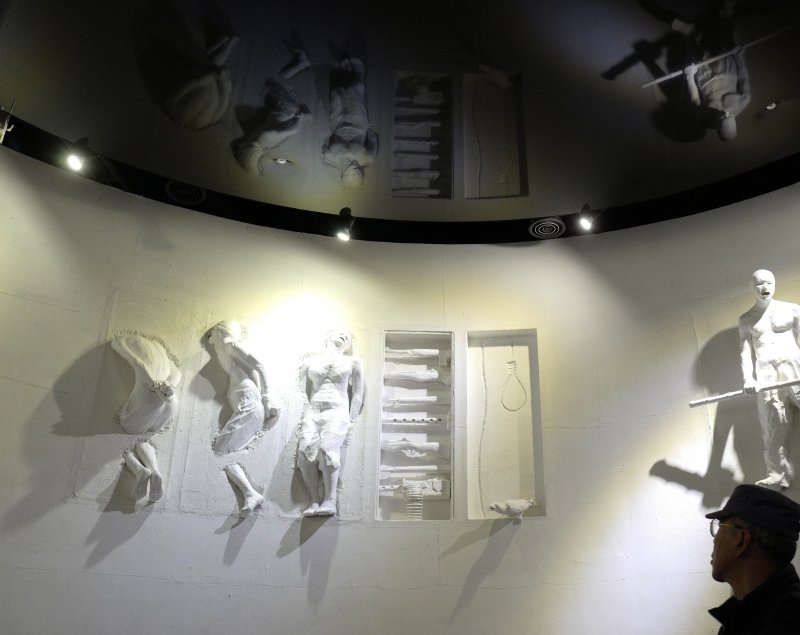US Attorney: Feds will stay in Portland until attacks end
IT'S THE FEDS CAUSING THE VIOLENCE,
AND ENCOURAGING IT
THEY ARE RIOT COPS CREATING A RIOT

1 of 17
A demonstrator shouts slogans using a bullhorn next to a group of military veterans during a Black Lives Matter protest at the Mark O. Hatfield United States Courthouse Sunday, July 26, 2020, in Portland, Ore. (AP Photo/Marcio Jose Sanchez)
DISARM, DEMILITARIZE, DEFUND
PORTLAND, Ore. (AP) — Federal militarized officers will remain in Portland until attacks on the U.S. courthouse cease, a top official said Monday after a night of violence. And more officers may soon be on the way.
“It is not a solution to tell federal officers to leave when there continues to be attacks on federal property and personnel. We are not leaving the building unprotected to be destroyed by people intent on doing so,” U.S. Attorney Billy Williams told a telephonic news conference.
Local and state officials said the federal officers are unwelcome. The mayor of Portland and five other cities appealed Monday to Congress to make it illegal for the federal government to deploy militarized federal agents to cities that don’t want them.
“This administration’s egregious use of federal force on cities over the objections of local authorities should never happen,” the mayors of Portland, Seattle, Chicago, Kansas City Albuquerque and Washington D.C. wrote to leaders of the U.S. House and Senate.
The mayors want Congress to require consultation with and consent from local authorities before federal deployments; require visible identification at all times on federal agents and vehicles unless on an undercover mission authorized by the local U.S. attorney; and limit federal agents’ activities to protecting federal property.

The city has had nightly protests for two months since the death of George Floyd in Minneapolis in May. President Donald Trump said he sent federal agents to Portland to halt the unrest but state and local officials said they are making the situation worse.
Full Coverage: Racial injustice
Trump’s deployment of the federal officers over the July 4 weekend fanned the flames of the Black Lives Matter protest movement here. The number of protesters had dwindled to perhaps less than 100 right before the deployment, and now has swelled to the thousands.
Early Monday, U.S. agents repeatedly fired tear gas, flash bangs and pepper balls at protesters outside the federal courthouse in downtown Portland. Some protesters had climbed over the fence surrounding the courthouse, while others shot fireworks, banged on the fence and projected lights on the building.
Trump said Monday on Twitter that the federal properties in Portland “wouldn’t last a day” without the presence of the federal agents.
The majority of those participating in the daily demonstrations have been peaceful. But a few protesters have been pelting officers with objects and trying to tear down fencing protecting the Mark O. Hatfield United States Courthouse.
At a press conference with two other federal officials, Williams, whose office is inside the courthouse, called on peaceful protesters, community and business leaders and people of faith to not allow violence to occur in their presence and leave downtown before violence starts. He said federal agents have made 83 arrests.
Demonstrations in support of racial justice and police reform in other cities around the U.S. were marred by violence over the weekend. Protesters set fire to an Oakland, California, courthouse; vehicles were set ablaze in Richmond, Virginia; an armed protester was shot and killed in Austin, Texas; and two people were shot and wounded in Aurora, Colorado, after a car drove through a protest.
The U.S. Marshals Service has lined up about 100 people they could send, either to strengthen the forces there or relieve officers who have been working for weeks, agency spokesperson Drew Wade said.
Kris Cline, principal deputy director of the Federal Protective Service, told the news conference that an incident commander discusses with Department of Homeland Security and Department of Justice teams at the courthouse what force requirements are needed every night.
Cline refused to discuss the number of officers that are currently present or if more are arriving.
Some protesters have accused Portland Mayor Ted Wheeler of hypocrisy for speaking out against the federal presence because, under his watch, Portland police have used tear gas and other riot-control weapons on protesters, including peaceful ones.
Cline said Portland police should take over from the federal officers the job of dispersing protesters from the courthouse area.
“If the Portland Police Bureau were able to do what they typically do, they would be able to clear this out for this disturbance and we would leave our officers inside the building and not be visible,” Cline said.
He said relations between the federal officers, some of whom live in Portland, and Portland police were good, but told reporters he was surprised when the police would not help remove protesters who were blocking an Immigration and Customs Enforcement building in 2018.
Sunday evening, Portland police responded to a shooting at a park close to the site of the overnight protests. Two people were detained and later released, police said Monday morning. The person who was shot went to the hospital in a private vehicle and was treated for a non-life-threatening wound.
Also late Sunday, police said someone pointed out a bag in the same park, where officers found loaded rifle magazines and Molotov cocktails. The shooting was not related to the items, police said. It was not clear whether the shooting or the material found in the bag was connected to the protests.
___
Associated Press writer Mike Balsamo contributed to this report from Washington. Selsky reported from Salem, Oregon.
___
Follow Andrew Selsky on Twitter at https://twitter.com/andrewselsky

1 of 17
A demonstrator shouts slogans using a bullhorn next to a group of military veterans during a Black Lives Matter protest at the Mark O. Hatfield United States Courthouse Sunday, July 26, 2020, in Portland, Ore. (AP Photo/Marcio Jose Sanchez)
DISARM, DEMILITARIZE, DEFUND
PORTLAND, Ore. (AP) — Federal militarized officers will remain in Portland until attacks on the U.S. courthouse cease, a top official said Monday after a night of violence. And more officers may soon be on the way.
“It is not a solution to tell federal officers to leave when there continues to be attacks on federal property and personnel. We are not leaving the building unprotected to be destroyed by people intent on doing so,” U.S. Attorney Billy Williams told a telephonic news conference.
Local and state officials said the federal officers are unwelcome. The mayor of Portland and five other cities appealed Monday to Congress to make it illegal for the federal government to deploy militarized federal agents to cities that don’t want them.
“This administration’s egregious use of federal force on cities over the objections of local authorities should never happen,” the mayors of Portland, Seattle, Chicago, Kansas City Albuquerque and Washington D.C. wrote to leaders of the U.S. House and Senate.
The mayors want Congress to require consultation with and consent from local authorities before federal deployments; require visible identification at all times on federal agents and vehicles unless on an undercover mission authorized by the local U.S. attorney; and limit federal agents’ activities to protecting federal property.

The city has had nightly protests for two months since the death of George Floyd in Minneapolis in May. President Donald Trump said he sent federal agents to Portland to halt the unrest but state and local officials said they are making the situation worse.
Full Coverage: Racial injustice
Trump’s deployment of the federal officers over the July 4 weekend fanned the flames of the Black Lives Matter protest movement here. The number of protesters had dwindled to perhaps less than 100 right before the deployment, and now has swelled to the thousands.
Early Monday, U.S. agents repeatedly fired tear gas, flash bangs and pepper balls at protesters outside the federal courthouse in downtown Portland. Some protesters had climbed over the fence surrounding the courthouse, while others shot fireworks, banged on the fence and projected lights on the building.
Trump said Monday on Twitter that the federal properties in Portland “wouldn’t last a day” without the presence of the federal agents.
The majority of those participating in the daily demonstrations have been peaceful. But a few protesters have been pelting officers with objects and trying to tear down fencing protecting the Mark O. Hatfield United States Courthouse.
At a press conference with two other federal officials, Williams, whose office is inside the courthouse, called on peaceful protesters, community and business leaders and people of faith to not allow violence to occur in their presence and leave downtown before violence starts. He said federal agents have made 83 arrests.
Demonstrations in support of racial justice and police reform in other cities around the U.S. were marred by violence over the weekend. Protesters set fire to an Oakland, California, courthouse; vehicles were set ablaze in Richmond, Virginia; an armed protester was shot and killed in Austin, Texas; and two people were shot and wounded in Aurora, Colorado, after a car drove through a protest.
The U.S. Marshals Service has lined up about 100 people they could send, either to strengthen the forces there or relieve officers who have been working for weeks, agency spokesperson Drew Wade said.
Kris Cline, principal deputy director of the Federal Protective Service, told the news conference that an incident commander discusses with Department of Homeland Security and Department of Justice teams at the courthouse what force requirements are needed every night.
Cline refused to discuss the number of officers that are currently present or if more are arriving.
Some protesters have accused Portland Mayor Ted Wheeler of hypocrisy for speaking out against the federal presence because, under his watch, Portland police have used tear gas and other riot-control weapons on protesters, including peaceful ones.
Cline said Portland police should take over from the federal officers the job of dispersing protesters from the courthouse area.
“If the Portland Police Bureau were able to do what they typically do, they would be able to clear this out for this disturbance and we would leave our officers inside the building and not be visible,” Cline said.
He said relations between the federal officers, some of whom live in Portland, and Portland police were good, but told reporters he was surprised when the police would not help remove protesters who were blocking an Immigration and Customs Enforcement building in 2018.
Sunday evening, Portland police responded to a shooting at a park close to the site of the overnight protests. Two people were detained and later released, police said Monday morning. The person who was shot went to the hospital in a private vehicle and was treated for a non-life-threatening wound.
Also late Sunday, police said someone pointed out a bag in the same park, where officers found loaded rifle magazines and Molotov cocktails. The shooting was not related to the items, police said. It was not clear whether the shooting or the material found in the bag was connected to the protests.
___
Associated Press writer Mike Balsamo contributed to this report from Washington. Selsky reported from Salem, Oregon.
___
Follow Andrew Selsky on Twitter at https://twitter.com/andrewselsky


















